Technologies à lit fluidisé / Fluid bed and spouted bed technology
A particularly gentle process
Sensitive raw materials, especially those of natural origin or volatile substances, require particularly gentle process control. Spray granulation, spray coating and microencapsulation processes have proven to be the method of choice, as they enable a high yield, low temperatures and bespoke properties.
- Author: Dr. Michael Jacob, Head of Process Technology Food, Feed & Fine Chemicals, Glatt Ingenieurtechnik GmbH
- originally published in the trade magazine ‘Expression Cosmetique’, issue 11/2019, EC PRESSE
- EC60 (zone-secure.net)
When it comes to cosmetics, product development often focuses on proven, multi-functional ingredients. This is in addition to the ongoing demand for natural ingredients, as consumers increasingly look for effective cosmetic products that neither harm their health nor the environment. Glatt Ingenieurtechnik, the German expert in particle design, process development and plant engineering, offers unique solutions in particle processing based on fluidized bed and spouted bed technologies for washing-active substances, stabilizers, enzymes, fragrances, aromas and vitamins, essential oils, collagens, and controlled release mechanisms, all of which can be optimally produced, protected and refined.
Enhanced properties, improved performance
The processes by which product properties can be influenced and improved have long been established, and are also used in other industries in the development of next-generation materials: Spray granulation, spray agglomeration, spray coating or (micro)spray encapsulation can be used to optimize the properties and functionality of sensitive raw materials for new formulations. This not only improves solubility, but also ensures that ingredients are homogeneously distributed in particles with a broad, adjustable size spectrum. For larger particles, which may have to be coated, a fluidized bed is a must. In general, the functionalized substances can be compacted and dosed better, and thanks to their dust-free properties, are much safer in handling. They are more stable in storage and can be color-matched to the product design. A functionalized surface ensures tailor-made application properties, and solubility, dispersibility, release behavior and homogeneity are just a few of the parameters that can be specifically adjusted.
Groundbreaking process
Unique flow-mechanical and thermodynamic properties make fluid bed technology a groundbreaking process for optimizing powders and liquids, (see Table 1). Drying and product design are thus possible in one process step using the same apparatus. A fluidized bed is created when upwardly flowing process air lifts a layer of solid particles, thus fluidizing them. The process air is used to generate the fluidized bed state. In addition to the thermal treatment of solids, fluidized bed processes are used for drying tasks, the construction of granulates from powders (spray agglomeration) or from liquids (spray granulation) and the coating of particles (spray coating). In the fluidized bed, the particles behave in principle like a liquid. All particles are mixed intensively so that a uniform treatment temperature is guaranteed in the entire bed. This enables not only a highly controllable drying process, but also a gentle treatment of temperature-sensitive substances.
Spouted bed for temperature sensitive substances
When it comes to heat or temperature sensitivity of active substances such as essential oils or collagens, spouted bed is the method of choice. The spouted bed technology is also based on the basic principle of fluidizing particles by upwardly flowing process air, making it possible to formulate and functionalize such materials economically in a single process step – batchwise or continuously, in single-stage or multi-stage processes. Overall, both technologies help to protect volatile substances and enhance handling and dosing. The difference between the concepts lies in the fluid mechanics and process dynamics. This results in significantly higher heat and mass transfer rates for processing sensitive products in shorter times. It’s possible to work at very low temperatures with short processing times, and thermal damage can be avoided at very product temperatures.
Spray granulation and (micro)encapsulation
Spray granulation is an optimal process for the production of solid ingredients from liquids and powders. Liquid substances often react unpredictably when they come into contact with each other. But when converted into dry granules, their reaction properties can be clearly defined. Microencapsulation is based on the spray granulation process and so also delivers compact, dust-free, easy-flowing and easy to dose granules from liquid and particularly sensitive raw materials. They can be homogeneously distributed and embedded in a protective matrix (see Figure 1). The process is an ideal solution, for example, to stabilize and functionalize aromas or volatile essential oils. The starting point is normally an oil-in-water emulsion that must be carefully adapted to the process. Hence, the emulsion must have the correct droplet size and stability during processing. Spray granulated/encapsulated particles can be loaded with active substances in a high concentration.
The advantages of this process also include improved shelf life due to reduced hygroscopicity, and better transport and dosing properties of the product. At the same time, the water solubility of the granules can be specifically adjusted. The granules are built up and then dried in a single process step: liquids are sprayed onto fluidized particles and dry on their surface. This results in layered particle growth. The small particles required for further granulate build-up are generated in the process itself. Only the liquid raw material – the emulsion – has to be provided. In addition, it is possible to feed powdery or fine-particle solids into the process in a targeted manner in order either to integrate them homogeneously into the granulate structure, or to use them as external starting cores for granulate growth.
Carrier systems
The method described above also allows the loading of porous granulates with solid auxiliaries (see Figure 2). Solid substances in powder form must be sufficiently well dispersed in the liquid to be dried or insoluble liquids emulsified. During the subsequent spray granulation, the finely divided active substances are fixed in the solid carrier matrix dissolved in the liquid. As an alternative to encapsulation in homogeneous, compact matrices, the spray liquid can also be sprayed onto carrier particles. Suitable base materials are, for example, application-compatible powders or inert carrier granules. The particle structure can be adjusted to specific requirements by variation of the formulation and the process parameters. Suitable carrier systems are for example xylitol, maltodextrin, lactose. Here, too, the combination of granulate formation and release control takes place in a single step. With the aid of process-accompanying analysis of the active substance content or other important particle properties such as size, bulk density or residual moisture, the process can be quickly adapted to the desired product properties. The final product is porous and easily dispersible, for example into shampoo or another viscous fluid, and has a lower load of active substances, which is desirable for fragrances. The time at which the fragrance unfolds can be specifically set. When it comes to fat-soluble fragrances, vitamins or collagen, a hot melt processing or coating is achievable (see Figure 3). For example, the lipid is melted and the active ingredient dissolved to produce small particles or pellets that are released when rubbed onto the skin.
Small specialty system
Anyone who deals with specialities for certain applications and does not produce in the ton range can have independence with his own small plant. The ProCell LabSystem (see Figure 4) is not only a laboratory system for testing spouted bed and fluid bed processes on a kg scale; but the mobile and flexible system is also used for the production of specialities. Products can be manufactured using all four processes, i.e. spray granulation from liquids, spray agglomeration from powders, coating and microencapsulation of liquids. This is made possible by various inserts, which influence the geometry and expansion of the process chamber, and thus the flow pattern and the fine-tuning of the process parameters.
Further information on this topic and related topics can also be found in the following publications:
Published article: ‘Encapsulating volatile substances – Product optimization with artificial neural networks’. PDF, German
Published article: ‘Hot-melt applications for the food and beverage industry – How to safely stabilize vitamins and probiotics’ PDF, English
Published article: ‘Spray (micro)encapsulation of sensitive substances in matrix form – An overview of essential oil and vitamin case studies’ PDF, English
Published article: ‘Contract manufacturing by fluid bed and spouted bed technology: Which is better, continuous or batch process?’ PDF, English
Published article: ‘The gentle processing of highly volatile oils by fluid bed and spouted bed technology’ PDF, English


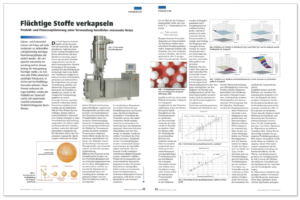
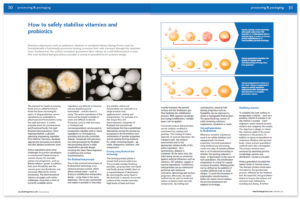
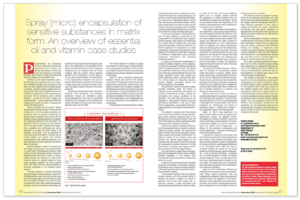
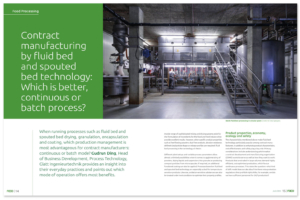
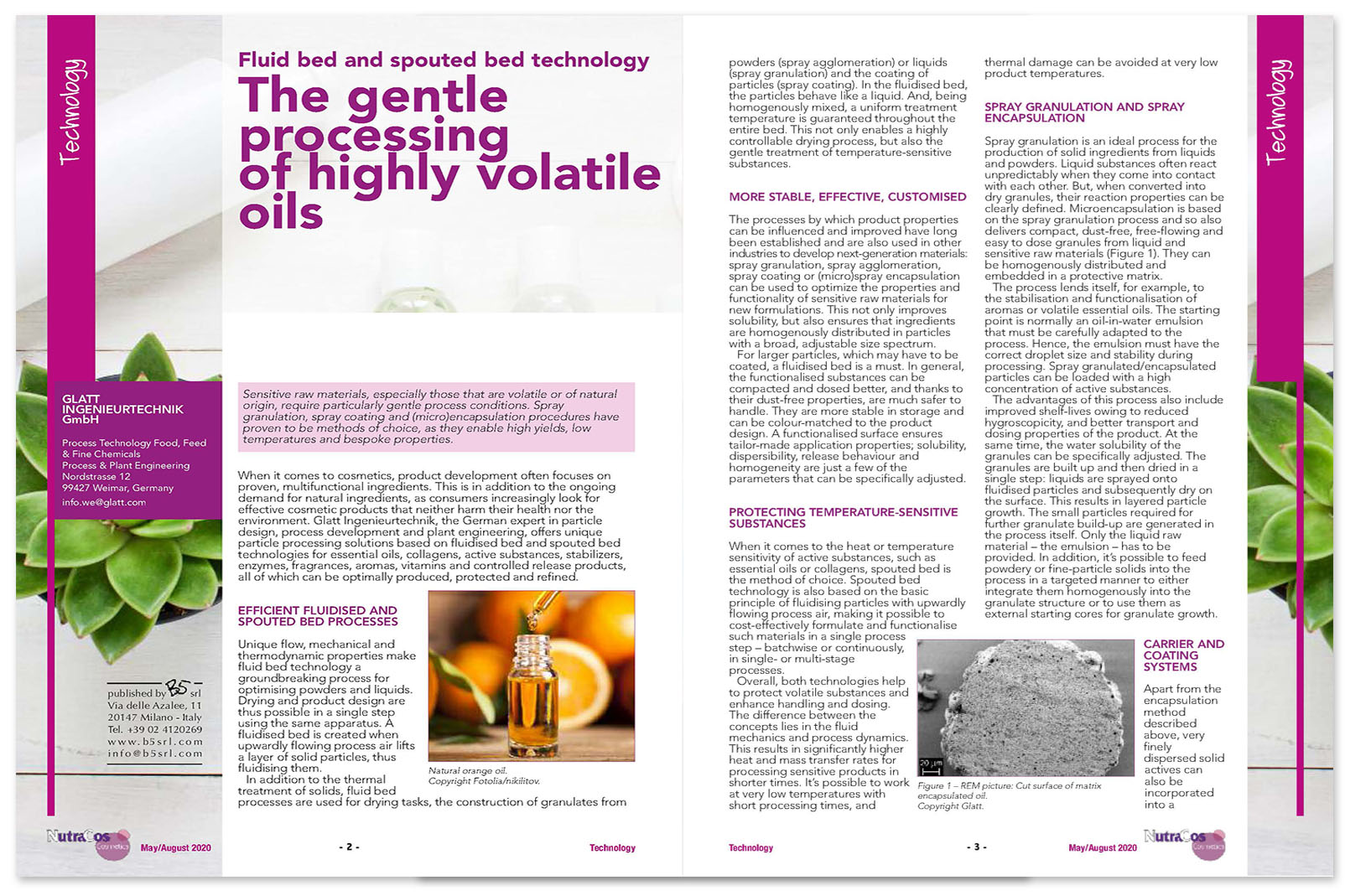
 Copyright: Innovations in Food Technology
Copyright: Innovations in Food Technology Copyright: Göller Verlag
Copyright: Göller Verlag